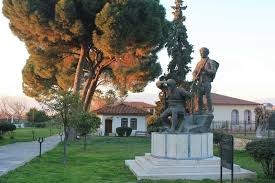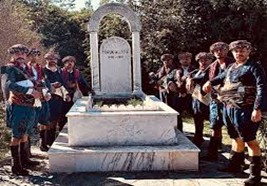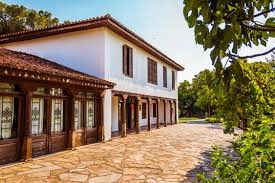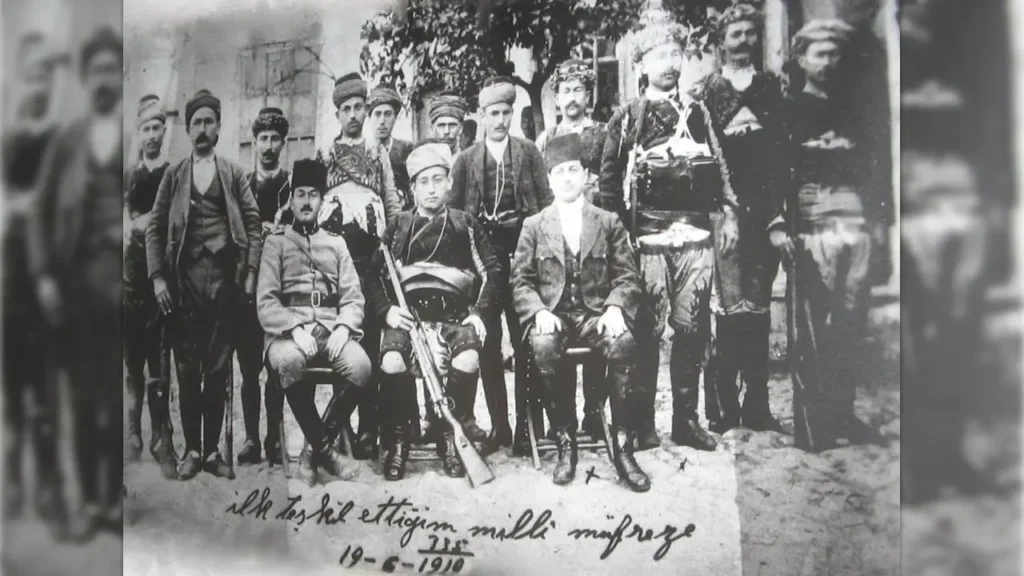A Young Man in the Late Ottoman Era
My great-grandfather, Yörük Ali Efe, was born in 1895 in Kavaklı Village, in the district of Sultanhisar, Aydın. His father, Abdi, was the son of İbrahim from the Sarıtekeli tribe, and his mother was Fatma from the Atmaca tribe. Ali encountered the harsh realities of the mountains and plains at a very young age. The region’s challenging conditions shaped his character early on. By the age of 19, he had set out to join the group of Alanyalı Molla Ahmet, one of the most respected efes of the Aegean. Yet, being accepted into a zeybek band was no easy feat. To become a “kızan” (apprentice), one had to pass tests of courage, loyalty, and trustworthiness. Yörük Ali successfully overcame all these demanding trials. His skill with weapons, agility in the mountains, and honesty among his peers soon drew the attention of Molla Ahmet Efe. Thus, he became one of the group’s most trusted members and took part in critical missions.
The turning point in Yörük Ali’s life came with the Kavaklıdere Raid in Bozdoğan. In this clash, Molla Ahmet Efe was gravely wounded and lost his life. The group was left without a leader; the election of a new chief was now inevitable. Thanks to his courage, fair demeanor, and experience, Yörük Ali became everyone’s choice. From that moment on, he was known as “Yörük Ali Efe” and took up the banner of resistance. From the day he assumed leadership, he spent nearly four years roaming the mountains, organizing the resistance. Yet he was not merely a militia leader; he also became a figure in whom the people placed their trust. He listened to the grievances of villagers, aided those in need, and strove to maintain order in the region. His fair and rational decisions…
The First Light of the National Struggle: The Rise of the Zeybeks
In the final years of the Ottoman Empire, the zeybeks were seen by the people as symbols of justice. Yet, with the occupation of İzmir on May 15, 1919, this tradition took on an entirely new mission. The zeybeks were no longer merely warriors seeking solutions to local disputes; they became the vanguards of a full-fledged struggle for national independence. Among the most important figures of this transformation was my great-grandfather, Yörük Ali Efe. The first great sign of this new era was the Malgaç Raid, which entered history as “the spark of resistance.”
The Malgaç Raid went down in history as one of the earliest and most symbolic actions on the Western Front of the War of Independence. On June 16, 1919, under the leadership of Yörük Ali Efe, a militia force of about 60 men—comprising efes, villagers, and soldiers—targeted the Greek outpost guarding the Malgaç Bridge on the İzmir–Aydın railway. The outpost was destroyed in a short time, and munitions and supplies were seized, strengthening the Kuva-yı Milliye. This raid was not only a military victory; it was also a beacon of hope for a people plunged into despair. The belief in the invincibility of the Greek army was shaken, and the populace regained faith in their own strength. This surge of morale encouraged many other efes and villagers in the region to join the Kuva-yı Milliye. Malgaç had ceased to be a mere military operation; it had become a nationwide symbol of resistance. Even the fall of a small outpost caused panic among Greek forces, compelling the units stationed in Nazilli to retreat toward Aydın. This event proved that even minor victories at the front could disrupt the enemy’s strategy.
The success of the Malgaç Raid quickly created a “wave” effect, paving the way for new raids. These were not isolated, disconnected incidents. On the contrary, they developed as a tactical chain, each triggering the next and creating a synergistic force. Indeed, the Erbeyli Raid, carried out only a few days after Malgaç, was the clearest sign of this coordinated resistance. The panic sparked by one raid and the enemy’s need to mobilize reinforcements opened up new opportunities for others. This showed that the Kuva-yı Milliye was not just a local uprising but the product of strategic thought. The struggles at Tellidede and Köşk were also continuations of this wave of resistance. These raids conveyed one clear message to the people: “Something can be done.” Fear gave way to courage; despair gave way to organized resistance. In this way, the collective consciousness of a people began to transform. Through his acts of bravery, Yörük Ali Efe became one of the icons of this resistance and came to be remembered among the people as “the Efe of Efes.”
The Road to the Republic
Yörük Ali Efe’s role in the National Struggle stands out as a symbol of the transformation from the leadership of a local militia force into an official part of the national army. The “National Aydın Regiment” under his command was a striking example of civil-military cooperation, composed of kızans, officers, civil servants, soldiers, and volunteers. With its raid on the fully armed enemy outpost near the Malgaç Railway Bridge on June 16, 1919, this unit carried out the first planned and deliberate act of resistance against the enemy in Western Anatolia.
Yet it soon became clear that, while the Kuva-yı Milliye excelled in raids and guerrilla warfare, it lacked the discipline and order required for pitched battles. The dispersal and retreat of the militia forces on the Gediz Front was the most striking example of this limitation. This made the establishment of a regular army no longer just desirable, but “an unavoidable necessity.” The Grand National Assembly (TBMM) government decided to unify the scattered militia forces under a single command structure. This transformation was formalized with the appointment of Yörük Ali Efe, holding the rank of Milis Miralay, to the command of the National Aydın Front. The title Miralay corresponds to today’s rank of colonel. This appointment demonstrated that Yörük Ali Efe was no longer merely a local efe but an official officer of the national army.
However, this process was more than a simple change of rank. The National Aydın Regiment under his command was restructured into the 37th Infantry Regiment following the establishment of the Western Front, and placed under the command of Colonel Şefik Bey. This organizational change showed that Yörük Ali Efe personally experienced the transition from the Kuva-yı Milliye to the regular army and was integrated into the central chain of command. Moreover, he succeeded in becoming part of the national effort without compromising his strong local identity.
For his distinguished service and acts of bravery in the National Struggle, Yörük Ali Efe was honored by the TBMM with the Medal of Independence (İstiklâl Madalyası). After the Turkish War of Independence, this medal—regulated by a special law—was the highest symbol of gratitude and recognition. The medal awarded to Yörük Ali Efe was the “Red-Ribboned Medal of Independence.” The red ribbon symbolized the highest distinction, given to those who had served directly on the active fronts of the war, risking their lives. This detail was a mark of honor distinguishing his active role at the front from those serving in the rear.
One of the modernization steps of the Republic, the 1934 Surname Law, also marked a personal milestone in Yörük Ali Efe’s life. With this law, his name entered official records with the surname “Yörük,” proving that his personal identity and the national identity had merged into a harmonious whole. Thus, Yörük Ali Efe became not only an efe or a resistance leader, but a figure deeply rooted in the collective memory of the Republic—honored also through his cultural identity.
After the War of Independence, Yörük Ali Efe chose civilian life rather than pursuing an official career in the newly established Republic. He first settled in İzmir; however, in 1928 he suffered a tram accident in which he lost his legs. This great misfortune made his life more difficult, but it did not prevent him from holding on to life. In the eyes of the people, once carried on shoulders for his heroism, Yörük Ali Efe returned to Yenipazar, in Aydın province, and lived as a modest farmer and businessman. His bond with the land was not merely a matter of livelihood but also of identity. The saying, “A man of Yenipazar loves the land, and he who loves the land loves people,” expressed his affection for his homeland in the simplest form. That love also revealed itself in his will: at the end of his life, he wished to be buried in Yenipazar.
In later years, having fallen ill with diabetes, Yörük Ali Efe passed away on September 23, 1951, at Bursa State Hospital. In accordance with his will, his body was brought to Yenipazar and buried beside his mother, Fatma Hanım, in Muslu Kuyu Cemetery. However, years later, as a mark of respect for his legacy, the location of his grave was changed. By decision of the Council of Ministers dated August 29, 2000, numbered 2000/1252, his remains were transferred to the garden of his former home in Yenipazar. Today, his grave, located in the garden of this house—now serving as a museum—is not merely a family memorial; it has become a monumental grave representing the shared memory of both state and nation.
The Place of Memory: Yörük Ali Efe Museum
Today, one of the most important places that keeps his memory alive is the Yörük Ali Efe Museum in Yenipazar. This museum not only displays the personal belongings of a hero but also preserves the spirit of resistance of the Aegean. Yet its establishment was made possible not only by the state but also by the efforts of the family. In particular, the devotion of Kayhan Kavas—my father, and the grandson of my great-grandfather—cannot be forgotten. Thanks to his years of effort, research, initiatives, and persistence, the memory of Yörük Ali Efe gained a tangible home. My father worked to safeguard this legacy not only as a grandson but also as a bureaucrat and statesman. At last, as a result of these efforts, Yörük Ali Efe’s house, to which his remains were transferred by decision of the Council of Ministers, was restored and opened to visitors as a museum in 2001. Today, this museum, standing tall in Yenipazar, is a monument of pride imbued with meaning through such devoted endeavors.




Yörük Ali Efe Museum, Yenipazar/ Aydın
The Legacy Left to Today
On the 74th anniversary of his passing, I remember not only a family elder but also a symbol of a nation’s resistance. For I know that if we live today as free citizens of a free homeland, it is thanks to Mustafa Kemal Atatürk, his comrades-in-arms, my great-grandfather Yörük Ali Efe, and all our heroes. In the darkest moments of despair, they sowed courage in the hearts of the people and hope in the soil of the homeland.
May your soul rest in peace, Yörük Ali Efe… Your path is our path. Your name, once echoing through the mountains, continues to live on today in the memories displayed at the museum, in the stories told in village coffeehouses, and in the songs that resonate in people’s hearts. For every voice that sings your song is, in truth, the voice of freedom, of valor, and of the people’s conscience.


